The Veterinary Wound Cleansers Market is estimated to be valued at USD 224.9 million in 2025 and is projected to reach USD 594.0 million by 2035, registering a compound annual growth rate (CAGR) of 10.2% over the forecast period.
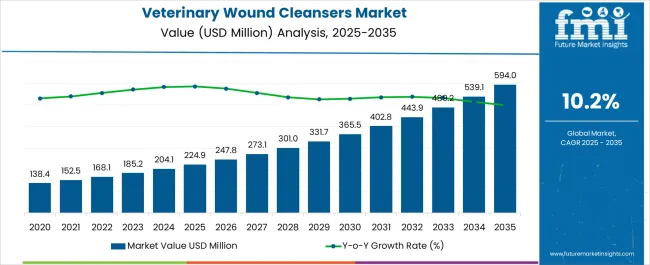
| Metric | Value |
|---|---|
| Veterinary Wound Cleansers Market Estimated Value in (2025 E) | USD 224.9 million |
| Veterinary Wound Cleansers Market Forecast Value in (2035 F) | USD 594.0 million |
| Forecast CAGR (2025 to 2035) | 10.2% |
The veterinary wound cleansers market is advancing steadily, driven by the rising emphasis on animal health and the increasing demand for effective wound management solutions in both companion and livestock animals. Industry publications and veterinary healthcare updates have emphasized that pet ownership growth, along with higher healthcare spending for companion animals, has significantly expanded the use of advanced wound care products.
Developments in veterinary medicine, including the adoption of antiseptic formulations and bioactive cleansing agents, have enhanced treatment efficacy and minimized infection risks. Additionally, the expansion of veterinary care infrastructure and greater awareness among pet owners regarding preventive and post-surgical care have supported product adoption.
Regulatory approvals for novel veterinary wound care formulations and investments in animal healthcare research have further contributed to market momentum. Looking ahead, growth is expected to be reinforced by the rising incidence of injuries, surgeries, and chronic conditions in animals, coupled with the increasing role of veterinary hospitals and clinics in delivering advanced wound management solutions.
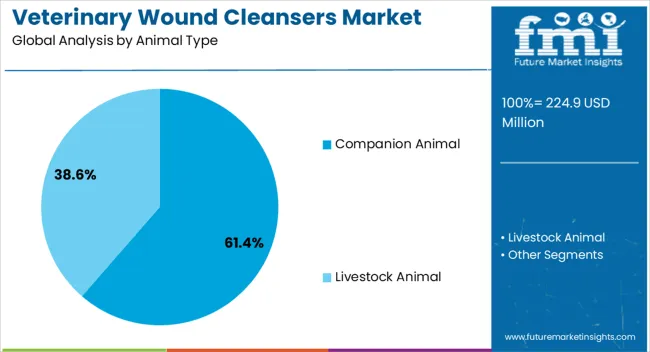
The Companion Animal segment is projected to account for 61.4% of the veterinary wound cleansers market revenue in 2025, establishing itself as the leading animal type category. Growth in this segment has been driven by the rising number of pet adoptions and increased healthcare expenditure by owners, who view pets as integral family members.
Veterinary journals have highlighted a growing prevalence of surgical interventions, dermatological conditions, and accidental injuries in pets, creating sustained demand for wound cleansers. Companion animals have been increasingly treated with advanced antiseptic solutions and bioactive cleansers that promote healing while minimizing infection risks.
Industry reports have indicated that innovations in product formulations—such as non-toxic, alcohol-free, and pH-balanced cleansers—are being tailored specifically for pets, further supporting adoption. With expanding awareness of preventive care and heightened access to veterinary services, the Companion Animal segment is expected to maintain its dominant position in the market.
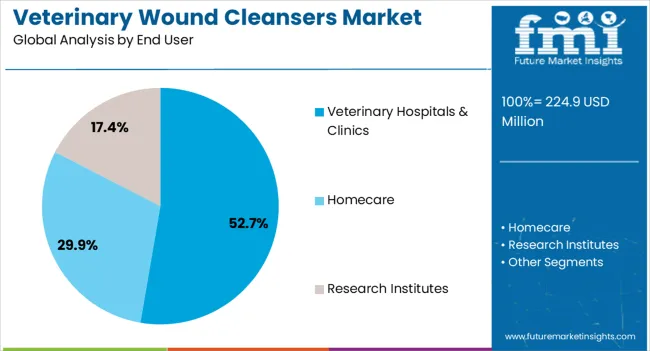
The Veterinary Hospitals & Clinics segment is projected to hold 52.7% of the veterinary wound cleansers market revenue in 2025, sustaining its leadership among end users. This growth has been supported by the availability of advanced veterinary infrastructure, trained professionals, and specialized equipment that facilitate effective wound management.
Veterinary hospitals and clinics have been the primary centers for performing surgeries, emergency care, and post-operative recovery, all of which require consistent use of wound cleansers. Press releases from animal health companies have underscored strategic partnerships with veterinary clinics to enhance product accessibility and clinical use.
Moreover, veterinarians have favored clinically validated cleansers to ensure safe and effective outcomes in both acute and chronic wound care. Increasing investments in expanding veterinary hospital networks, particularly in urban areas, and rising demand for specialized animal care services have strengthened this segment’s position. As awareness of comprehensive animal healthcare grows, Veterinary Hospitals & Clinics are expected to remain the leading channel for wound cleanser adoption.
The global market recorded a historic CAGR of 8.0% in the last 10 years from 2012 to 2025.
Around 15% of the USD 1.13 Billion advanced wound care market is contributed by the veterinary wound cleansers market.
The increased number of animal procedures is a key factor driving the veterinary wound cleansers market. The number of veterinary surgeries performed worldwide has increased as more pet owners prioritize the health and well-being of their animal companions. These surgeries can range from common treatments like spaying and neutering to more difficult operations like orthopedic surgery or tumor excision.
Several causes are driving the growing trend of animal surgery. For starters, pet owners are more ready to engage in advanced medical procedures, including surgical operations, for their dogs.
This shift in attitude toward dogs as cherished family members has resulted in a greater need for veterinary surgeries and, as a result, a greater demand for wound cleansers to aid in post-operative wound care and surgical site infection (SSI) wounds.
Likewise, advances in veterinary medicine have increased the number of surgical choices available to animals. Surgery has become safer and more accessible as a result of new procedures, improved anesthetic, and improved surgical instruments. This has encouraged more veterinarians to undertake procedures, which has increased the number of customers for wound cleanser makers.
Also, as the relevance of wound care in veterinary medicine has grown, veterinarians and pet owners have prioritized post-operative wound management. Proper wound cleansing is critical for avoiding infections, facilitating healing, and guaranteeing successful surgical outcomes. Because of this increased awareness, there is a greater demand for high-quality wound cleansers created expressly for veterinary usage.
In a nutshell, the increase in animal surgeries is a significant market growth driver for the veterinary wound cleanser market, driven by pet owners' increased investment in pet healthcare, advancements in veterinary medicine, the prevalence of chronic diseases, and growing awareness of wound care.
A prominent growth factor for the veterinary wound cleanser industry is the rising cost of veterinary healthcare. Pet owners are prepared to spend more on veterinary services and goods as they become more aware of the value of giving their animal friends top-notch healthcare.
Preventive care, diagnostics, therapies, and post-operative wound care are all included in this increase in veterinary healthcare spending. In order to ensure appropriate healing and reduce the risk of problems, wound cleansers are essential in the post-operative care of wounds.
The rising cost of veterinary healthcare suggests a greater need for efficient wound cleansers made specifically for veterinary usage. By providing unique and specialized solutions that satisfy the changing needs and expectations of pet owners and veterinary experts, manufacturers in the veterinary wound cleansers market can benefit from this growth driver and drive market expansion.
The veterinary wound cleansers market growth is constrained by low awareness among pet owners regarding product and acceptance rates. Even some healthcare experts and pet owners are unaware of the availability and advantages of specialized wound cleansers, despite the significance of good wound care in veterinary medicine.
The widespread use of veterinary wound cleansers is hampered by this low level of understanding. Additionally, due to familiarity and perceived cost-effectiveness, classic wound care techniques such as using basic saline solutions or antiseptic solutions are frequently used.
Manufacturers face difficulties in gaining market share and educating potential customers about the benefits of utilizing specialized wound cleansers for efficient wound treatment in animals due to the low level of knowledge and limited adoption of veterinary wound cleansers.
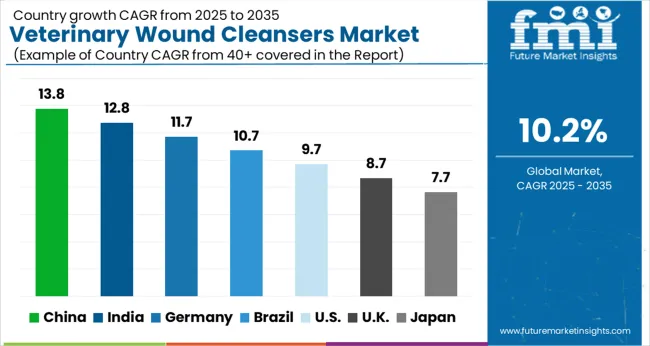
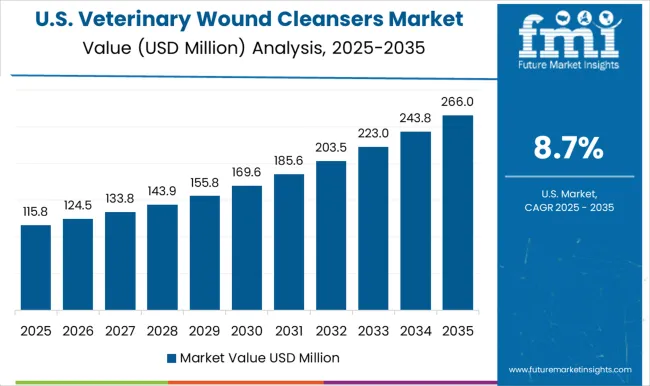
The USA dominates with a total market share of 27.2% in 2025 and is projected to continue experiencing high growth throughout the forecast period.
Increasing occurrence of orthopedic difficulties such as congenital hip dysplasia (CHD) and age-related problems are the prominent growth drivers for veterinary wound cleanser industry in the USA.
Orthopedic issues are common in animals, particularly in certain breeds, and may necessitate surgical intervention for diagnosis, treatment, or management. These procedures, which may include joint replacements, major fracture repairs, or ligament reconstructions, necessitate the use of competent wound cleansers for post-operative care.
As more pet owners become aware of these orthopedic disorders and seek appropriate medical care for their animals, the demand for veterinary-specific wound cleansers is likely to expand.
Veterinary wound cleanser makers must meet this market demand by developing safe and effective solutions for post-operative wound treatment in orthopedically challenged animals.
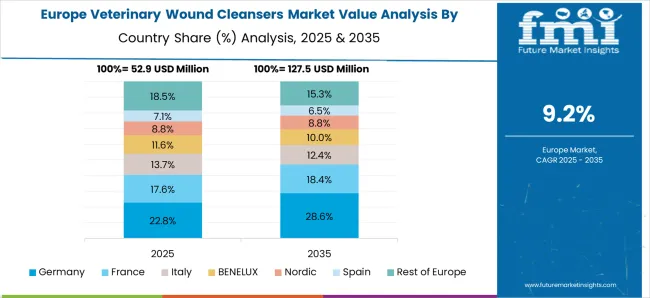
Germany holds a market share of around 6.4% in the global market in 2025.
A prominent growth factor for the veterinary wound cleanser industry is the increased availability and diversity of wound cleansers in Germany. German veterinary treatment is well-established, and animal health is highly prioritized.
There has been an increase in demand for a variety of wound cleansers that are specially designed for veterinary usage due to improvements in veterinary medicine and greater knowledge of wound care. As a result, there are now more and more types of wound cleansers like aerosol sprays, wound lotions, wound creams available in the German market to meet the needs of various wound types, sizes, and specifications.
Veterinarians and pet owners now have more access to and options for wound cleansers, giving them the chance to choose the best solutions for efficient wound management. The variety and accessibility of wound cleansers in Germany contribute to the country's total market for veterinary wound cleansers' expansion and growth.
United Kingdom holds a 5.4% share in the global market share in 2025.
The rising pet ownership rate in the United Kingdom is a key driver for the veterinary wound cleansers market growth. Pet ownership in the United Kingdom has steadily increased as more individuals and families appreciate the companionship and emotional support that pets bring.
Rising number of pet ownership subsequently raises the need for proper care and treatment, including wound management. Accidents, traumas, and surgical procedures are all prevalent in pets, resulting in wounds that must be effectively cleaned and cared for.
Pet owners attempt to ensure their cherished animals' well-being and quick recovery, increases the need for veterinary wound cleansers. Manufacturers of veterinary wound cleansers have been making profits from this trend by offering a variety of high-quality products created exclusively for pet wound care, appealing to the growing market of pet owners in the United Kingdom.
Companion animal hold a revenue share of 62.0% in 2025, and the same trend is being followed over the forecasted period.
Because of the growing number of pets and the growing awareness among pet owners about the need for wound care and healthcare for their animal companions, the companion animal segment dominates the animal type segment in the market for veterinary wound cleansers.
Veterinary hospitals & clinics hold a market share of 76.4% in 2025, within the forecasted period.
Due to the increased need for wound care products, the veterinary hospitals & clinics sector dominates the end user segment in global market. Veterinary hospitals and clinics provide primary care for animals, making them big users of veterinary wound cleansers for post-operative treatment and wound management.
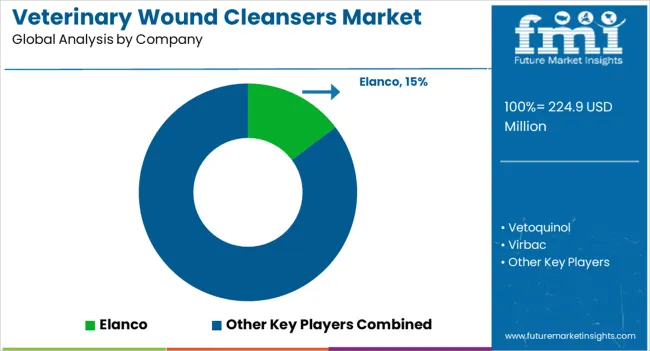
Strategic collaborations and research sponsorships are the key strategies adopted by manufacturers within this market to increase their product sales in different geographies.
Similarly, recent developments related to companies in veterinary wound cleansers market have been tracked by the team at Future Market Insights, which are available in the full report.
| Attribute | Details |
|---|---|
| Forecast Period | 2025 to 2035 |
| Historical Data Available for | 2012 to 2025 |
| Market Analysis | USD Million for Value |
| Key Regions Covered | North America; Latin America; Europe; South Asia; East Asia; Oceania; and Middle East & Africa |
| Key Countries Covered | USA, Canada, Brazil, Mexico, Argentina, United Kingdom, Germany, Italy, Russia, Spain, France, BENELUX, India, Thailand, Indonesia, Malaysia, Japan, China, South Korea, Australia, New Zealand, Türkiye, GCC Countries, South Africa, and Northern Africa |
| Key Market Segments Covered | Animal, End User and Region |
| Key Companies Profiled | Elanco; Vetoquinol; Virbac; Innovacyn, Inc.; Axio Biosolutions Pvt Ltd; Jorgen Kruuse; Dechra Pharmaceuticals; Neogen Corporation; Ethicon; Sonoma Pharma; AMERX Health Care Corp. |
| Report Coverage | Market Forecast, Competition Intelligence, DROT Analysis, Market Dynamics and Challenges, Strategic Growth Initiatives |
| Pricing | Available upon Request |
The global veterinary wound cleansers market is estimated to be valued at USD 224.9 million in 2025.
The market size for the veterinary wound cleansers market is projected to reach USD 594.0 million by 2035.
The veterinary wound cleansers market is expected to grow at a 10.2% CAGR between 2025 and 2035.
The key product types in veterinary wound cleansers market are companion animal and livestock animal.
In terms of end user, veterinary hospitals & clinics segment to command 52.7% share in the veterinary wound cleansers market in 2025.






Full Research Suite comprises of:
Market outlook & trends analysis
Interviews & case studies
Strategic recommendations
Vendor profiles & capabilities analysis
5-year forecasts
8 regions and 60+ country-level data splits
Market segment data splits
12 months of continuous data updates
DELIVERED AS:
PDF EXCEL ONLINE
Veterinary Point of Care Diagnostics Market Size and Share Forecast Outlook 2025 to 2035
Veterinary Allergy Diagnostics Market Size and Share Forecast Outlook 2025 to 2035
Veterinary TSE Testing Market Size and Share Forecast Outlook 2025 to 2035
Veterinary Dermatology Market Forecast Outlook 2025 to 2035
Veterinary Telemedicine Market Size and Share Forecast Outlook 2025 to 2035
Veterinary Dietary Supplements Market Size and Share Forecast Outlook 2025 to 2035
Veterinary Imaging Market Forecast and Outlook 2025 to 2035
Veterinary CRISPR-Based Detection Kits Market Size and Share Forecast Outlook 2025 to 2035
Veterinary Pregnancy Test Kit Market Forecast and Outlook 2025 to 2035
Veterinary X-Ray Illuminators Market Size and Share Forecast Outlook 2025 to 2035
Veterinary Scales Market Size and Share Forecast Outlook 2025 to 2035
Veterinary Grooming Aids Market Size and Share Forecast Outlook 2025 to 2035
Veterinary Micro-fibre Endoscope Market Size and Share Forecast Outlook 2025 to 2035
Veterinary Faecal Filters Market Size and Share Forecast Outlook 2025 to 2035
Veterinary Dental Equipment Market Size and Share Forecast Outlook 2025 to 2035
Veterinary Rapid Test Market Size and Share Forecast Outlook 2025 to 2035
Veterinary Therapeutic Diet Market Size and Share Forecast Outlook 2025 to 2035
Veterinary Glucometers Market Size and Share Forecast Outlook 2025 to 2035
Veterinary Pain Management Drugs Market Size and Share Forecast Outlook 2025 to 2035
Veterinary Anesthesia Machines Market Size and Share Forecast Outlook 2025 to 2035

Thank you!
You will receive an email from our Business Development Manager. Please be sure to check your SPAM/JUNK folder too.
Chat With
MaRIA